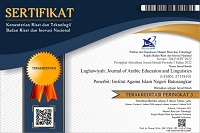KARAKTERISTIK LAGU-LAGU KEBANGSAAN ARAB: ANALISIS FONOLOGI
Abstract
This study aims to determine the phonetic characteristics of the Arabic national anthems. The object of this research is the national anthems of three countries, namely Saudi Arabia, Egypt, and Morocco. This research used a linguistic-phonetic approach. Data analysis used quantitative descriptive analysis. The results described that there were differences in vowel and consonant characteristics between the national anthems of Saudi Arabia, Egypt, and Morocco. Based on the number, the comparison in the national anthems of Saudi Arabia, Egypt, and Morocco was 84:156:142 for vowels, 15:44:19 for semi-vowels, and 82:161:110 for consonants. The Egyptian national anthem used long vowels (31.4%) more dominantly than the national anthems of Saudi Arabia and Morocco, while the Saudi Arabian national anthem used more thick (6%) and semi-thick (6%) vowels compared to Egyptian and Moroccan national anthems. For the consonant level, the three national anthems were dominated by alveodental consonants, the letters that come from the tip of the tongue, namely 39% for the Saudi Arabian, 34.2% for the Egyptian, and 36.4% for the Moroccan national anthems.
Keywords
Full Text:
PDFReferences
Ajram, N. (2014). Lagu-Lagu Arab Itu Bukan Hanya Qasidah Atau Nasyid. Www.Kompasiana.Com. https://www.kompasiana.com/nourajram/552917c96ea834f0448b4585/lagulagu-arab-itu-bukan-hanya-qasidah-atau-nasyid
Anis, I. (1990). al-Ashwat al-Lughawiyyah. Anglo Mashriyyah.
Fadhilah, F. N. (2020). Perubahan Bunyi Bahasa Arab Fusha ke dalam Dialek Mesir pada lagu Tamally Ma’ak. `A Jamiy : Jurnal Bahasa Dan Sastra Arab, 9(1), 47. https://doi.org/10.31314/ajamiy.9.1.47-68.2020
Kaelan. (2013). Pembahasan Filsafat Bahasa. Paradigma Yogyakarta.
Muslich, M. (2008). Fonologi Bahasa Indonesia Tinjauan Deskriptif Sistem Bunyi Bahasa Indonesia. Bumi Aksara.
Mansyur, F. M. (2011). Perkembangan Sastra Arab dan Teori sastra Islam. Pustaka Pelajar.
Marlina, L. (2019). Pengantar Ilmu Ashwat.
Muizzuddin, M. (2002). Analisis Fonologi Bahasa Arab, Tinjauan Linguistik Modern. ALQALAM, 19, 93, 67-90. http://jurnal.uinbanten.ac.id/index.php/alqalam/article/view/455
Nasution, A. S. A. (2010). Bunyi Bahasa. Jakarta: Amzah.
Nasution, A. S. A. (2012). Fonetik dan Fonologi Alquran. Jakarta: Amzah.
Rahadhi, I. S. (2015). Lagu Kebangsaan Kerajaan Arab Saudi - ’Aash Al-Malik. Http://Indrasr.Blogspot.Com/. http://indrasr.blogspot.com/2015/05/lagu-kebangsaan-kerajaan-arab-saudi-aash-al-malik.html
Suparno, D. (2018). Refleksi Variasi Fonologis Pada Fonem Bahasa Arab Mesir Dan Arab Saudi. Arabiyat : Jurnal Pendidikan Bahasa Arab Dan Kebahasaaraban, 5(2), 214–232. https://doi.org/10.15408/a.v5i2.7035
Zubaidah & Rahman, Y. (2019). Contemporary Arabic Songs and their Urgency in Learning Arabic Phonetics in the Industrial Revolution 4.0. 1st Bukittinggi International Conference on Education (BICED), 1(1). https://paper.biced.iainbukittinggi.ac.id/index.php/biced/article/view/40
DOI: http://dx.doi.org/10.31958/lughawiyah.v3i1.3191
Refbacks
- There are currently no refbacks.

This work is licensed under a Creative Commons Attribution-NonCommercial 4.0 International License.
Lughawiyah Indexed By:

Lughawiyah distribute under Lisensi Creative Commons Atribusi-NonKomersial 4.0 Internasional.
View My Stats lughawiyah




















